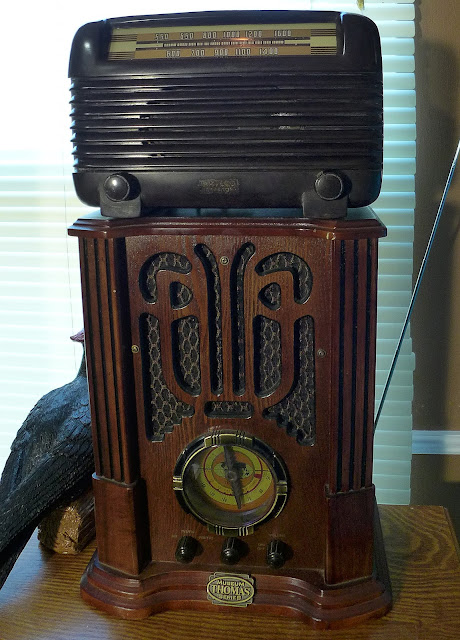December 30, 2024
#501
Gentle reader,
Since writing my 500th article, the 500,000th reader of The Robb Collections read one of my articles! When I set out to do this, it was just something fun to do, I had NO idea that folks around the world would be interested in what I have to say! I am truly thankful and humbled.
Last summer, Nancy and I were visiting our oldest daughter and three grandsons who live in the mountains of Virginia. We visited a local antique store and this radio caught my attention:
The poor thing was thickly and poorly painted with light green house paint! It spoke to my heart and the seller wanted only five dollars for it. My thinking was, that I could strip all the paint off and clean up the cabinet and all the components inside. Like I did with the Farm Radio my brother-in-law gave me: The Robb Collections: Restoring a 1937 Zenith 8S154H 6B06 TUBE Console Farm Radio
I know enough about tube electronics to NOT try and troubleshoot or repair them. Plus, the lack of a vacuum tube testing machine was also a problem. Tubes run at high voltages and can be very dangerous. So, I carefully removed the chassis, held in with only one screw plus the knobs and the AM antenna which was taped to the chassis all around the inside surfaces.
As this series of images show, the parts had decades of dust and cobwebs all over everything. Plus, as pointed out by the antiques dealer, the power cord rubber insulation was crumbling. I carefully removed it so that no one could try and plug it in.
The device at the left close to the back, with the big metal wheel attached to it, is the tuning device. I don't know it's official name. It was especially thick with dust and hard to turn.
Most of the tube numbers were still visible, not that I would be able to find replacements, nor did I need to do so. Cosmetic restoration means, "Make it all look nice."
I did not want to spray any contact cleaner or other types of electronic cleaners on the metal parts as they might remove their "patina".There is a barely readable model number right below the brown label. At first, I thought it was: 4S-250. But, it turns out to actually read: 46-250. Which means it was made in 1946, the first full year after the end of World War II which ended on August 15, 1946, with the surrender of the Japanese military and Emperor.
I could not decide which of these two images to use: Flash or none. So, posted both.
My plans changed when I decided to take a look on eBay to see if I could find a cabinet in good condition. Why? The green one had been broken into several pieces and roughly taped back together and painted. But, before I tell you what changed my mind: first, some images I found of what the 46-250 radio used to look like:
My original plans all changed when I found this beautiful radio on eBay for only $29.99. It looks identical to the 46-250, but, is in fact a "Philco PT-10 Transitone Radio". Made in 1941, the year in which the Japanese bombed Pearl Harbor, in Hawaii, "A date which will live in infamy!" President Franklin Roosevelt. Which dragged the American people into a war they really did not want to get into.
It even has the back panel and a new power cord!
 |
| You can see the orange glow of some of the tubes. |
One corner of the back bottom on the right side was broken in shipping, but easily fixed with some E6000 clear glue.
The inside components are super clean and the controls work smoothly. It was obvious that someone had taken very good care of this little radio which was made in 1941, 83 years ago!
So, I made sure it was off, plugged it in, switched it on, but left the volume at zero. After a couple of moments, I saw the tubes were glowing and then raised the volume. Buzz and some static. Then, I rotated the tuning knob and music! Latin music, heavy with accordion, but still it works! I tuned around the dial and heard two guys arguing football in English. Then, found Christian music on another station. Wow!
I used a wide angle lens to capture the stack of radios, which is why they appear to be leaning backwards.
I'm just tickled to finally have a fully working tube radio. This image is from 2012. All but the tall brown radio on the top shelf are tube radios. The Hallicrafters on the top left belonged to Nancy's dad. It did work, and may still, but I have not tried it in years. The off-white plastic one is a Zenith and all it did was buzz. The one on the far right did not work at all. ALL the others shown were found on eBay or locally and are transistor retro radios.
Thank you again for taking the time to read my humble blog. It truly is a labor of love.
Scott Robb
December 30, 2024
#501














































